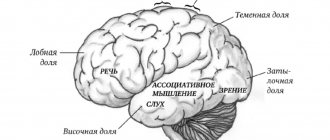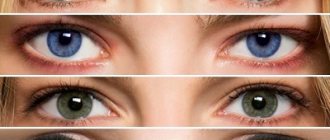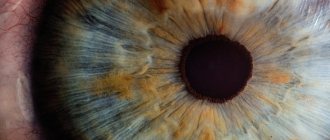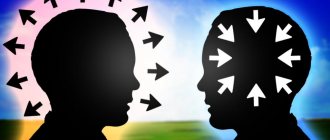General information about types of perception
Dividing people into visual, auditory, kinesthetic and digital in accordance with the basics of neuro-linguistic programming (NLP) allows us to identify their dominant sense organ. At the same time, one predominant sensory perception of the world in a person does not mean suppression of others. People typically have four channels through which they experience the world:
- Visual. With it, a person has a predominantly developed visual system for perceiving the surrounding reality. Color and shape matter to him.
- Auditory. The organ of hearing and the corresponding perception of the world through sounds, timbres, melodies, and volume dominate.
- Kinesthetic. The tactile function predominates. It is easier for a person to recognize this or that object by smell, taste, touch.
- Digital. The logical perception of the world dominates through the construction of an internal dialogue by a person.
The leading channel of a person’s worldview of information allows one to intensify mental activity. Thanks to it, other processes are launched in the form of memory and imagination.
There are several methods for identifying visual, auditory, kinesthetic and digital learners. The main thing is the diagnosis of the predominant modality through testing developed by S. Efremtsev. The test is available online for Internet users who want to find out their dominant type of perception.
Characteristics of auditory, visual, kinesthetic and digital learners include:
- the dominant organ involved in a person’s perception of the surrounding world;
- the influence of the leading channel of perception on character;
- correlation of the type of perception with a person’s personality type;
- a set of differences between one form of human assessment of the surrounding reality and others.
Characteristics of visuals
Auditory, visual, kinesthetic, and digital learners differ from each other in character, method of communication, and external signs. A feature of visual people is their perception of the world through visual images. Their dominant sense organ is their eyes. At the same time, other forms of assessing the world are no less developed in such people, but it is easier and more convenient for them to process incoming information through vision.
You can identify a visual person by their characteristic facial expressions. It serves as its distinctive feature. Much is determined by a person’s gaze:
- directed upward and to the left when trying to remember any information;
- up and to the right when fantasizing;
- straight and into the distance during mental activity.
These signs are typical for people with a predominant visual channel of worldview. By the look of a visual person, you can determine whether he is telling the truth or lying.
Interesting! A visual learner who is trying to tell a lie looks up and to the right when asked a specific question.
Visuals are characterized by the following features:
- perception of information through images;
- pronounced gestures;
- using the words “see”, “notice”, “it seems to me”, “take a look”, “look” when speaking;
- perception during the learning process only of visual information in the form of graphs, diagrams, drawings, photographs, experiments;
- paying attention to the appearance of other people, their facial expressions, gestures, postures;
- good imagination.
For a visual person, appearance is important. He is receptive to everything he sees. Such people appreciate the beauty of the world and its individual objects. They do not like dirt, sloppiness and disorder. If a child is a visual learner, then during the learning process he will better assimilate information presented to him in schematic and illustrated form.
People of this type master speed reading faster than others and perceive information better in the form of text. Visual learners are also characterized by visual memory. They remember the location of objects better than others and are well oriented in the area.
Visualists prefer to keep their distance when talking to other people. A comfort zone is important to them. Moreover, the distance between them and their interlocutors should be at least one meter. The gaze of visuals wanders and is in search. To successfully complete their tasks, such people need clear diagrams, visual pictures and images.
Auditory students at home
An auditory student needs silence to prepare homework. Any extraneous sounds will distract him. Parents do not need to talk to him, prevent him from reading out loud, or make monotonous sounds. This makes the auditor’s job easier.
Mathematics is easy for children with a developed sound channel. They are good logicians, understand algorithms and apply them in practice. In comfortable conditions they will succeed.
Parents can help cope with a task of high complexity: talk, analyze the condition of a problem, or plan a solution to an equation. Having done this out loud once, it will be much easier for the child to write everything down.
Auditory learners find it difficult to switch attention. Relatives should not distract a child who is doing homework. It is difficult for him, while reading a paragraph, to answer the phone, take out the trash, and then actively get to work again.
When memorizing a verse, the student needs to read it expressively and clearly several times. It is important for him to do lexical analysis and understand the general meaning. The parents' task is to help with the analysis and explain the meaning of unfamiliar words.
Auditory children often draw poorly and write sloppily. There’s no point in scolding them too much for this, that’s just nature. The student’s hearing is fine, but his vision is less developed.
But these guys have musical abilities. Knowing how to work with auditory children, you can provide your child with all the conditions and achieve certain results in this field. It is a known fact that among people with a dominant sound channel there are many successful musicians.
It is necessary to surround the baby with instruments from early childhood: keys, pipes, drums. Growing up, he will replace them with a guitar, piano or accordion. The best part is that the child will study on his own, without coercion.
The main task of parents is to provide their child with full communication and a comfortable sound environment. For a small audio audience, you need to carefully “filter the material.” We must ensure that children's ears hear less information that is not intended for them.
The most common and popular system for determining student types is VARK.
It was invented by New Zealand teacher Neil Fleming many years ago (in 1987), when he became an inspector, in order to make his work easier by researching the effectiveness of teaching children in . And in our harsh and information-filled times, this knowledge is used to understand which type of student a person is, and, accordingly, which learning method suits him best.
So, first, you need to find out what type your child is. Go to the website vark-learn.com
— here is the official test page, just select the checkbox with the required language at the top and answer the testing questions.
Your child is a visual learner.
It's not scary :) The author of this article is also a visual person, which is why he spent a lot of time creating the collages that you see here. As is clear from the definition, visual children remember better what they see. The point is not that they like them, although they really like them, but that any information that has at least some visual components is quickly stored in their memory. These components: graphs, diagrams, text highlighting, video fragments, posters, slides, and so on. It is easier for them to communicate with teachers who not only use all these components when explaining the material, but also if the teacher himself is charismatic, gestures a lot, and makes intonation accents during the lecture. Visual children need plenty of time and space to study material at home, prepare homework, or study for a test.
How to help a visual child learn easily and pleasantly:
- create good and comfortable things for him: a large desk, an assortment of stationery in the form of notepads, stickers of different colors and shapes, paper clips, pencils, markers, bookmarks, etc.
- buy or make your own catalogs to store information on cards (study cards with association pictures are the best way for your child to learn something).
- buy or make a flipchart for your child.
- allow him to stick and cover the walls of the room with educational posters and files, help in creating them and explain how they work if the child is using them for the first time.
- buy tutorials compiled in the form of tables and graphs with a simple and clear description of the rules and examples.
- Create a YouTube channel for your child where he can store useful and interesting video programs and courses.
- teach him to use interactive online resources and games for studying (there are truly a huge number of such resources, although the really smart ones have an English interface, but you also need to learn English).
Your child is an auditory learner.
For these children, unlike all the others, everything that flies into one ear does not fly out of the other, but lingers in the head, is thoroughly processed and issued in a stream of conclusions and hypotheses. They are diligent and attentive, they love to listen and talk. For auditory children, it is of great importance in development, so they need attention, from childhood, from parents, educators, and teachers. It is easier for auditory learners to study in small groups when the teacher can devote enough time to each student. Truth is born in discussion, which is why auditory learners can be very persistent and even a little annoying: when they come home from school, they tell in detail what happened, or, sitting down to do their homework, they fall on the phone with a classmate, discussing the solution to a problem in the process of solving it. Also, auditory learners are very attentive to details and are prone to lyrical digressions for an hour and a half: after all, it is so important to explain everything, and during the course of the explanation they can come to additional conclusions.
How to help an auditory child learn easily and pleasantly:
- Create a calm atmosphere for your child to study, a separate space, no loud extraneous sounds (buy headphones for all family members and watch TV that way, after all:)
- Since auditory learners listen to the teacher more than they write down, teach them to obtain additional information and expand their notes by reading them aloud.
- ask your child to explain to you out loud what he has understood or learned (not forcefully, but because of your sincere curiosity:)
- Buy your child the easiest-to-use player with a voice recording function; it will be useful not only at school, but also at university.
- Download audio books and audio courses for your child.
- teach your child, while concentrating while doing something (writing equations, dictation, etc.), to pronounce your actions out loud (if he is at home), in a whisper, or in his mind (at school).
- Encourage your child to participate in various conversation clubs (they are especially popular in the linguistic environment).
Your child is a kinesthetic learner.
These are practitioners in the truest sense of the word: they study the environment by sniffing, looking closely and feeling from all sides. It’s also nice if you can taste this very environment. Kinesthetic children are confident that they need to act, otherwise it is unknown whether it will work out or not. Therefore, they constantly test the strength of themselves, the world and the patience of their parents. They like stories from life and easily remember them, and are actively collecting wherever they go (shells, pebbles, bugs, etc.). Kinesthetic children love to be in nature, go to museums and exhibitions. For such children, in order to understand the structure of a toad, it is better to see it in cross-section in formaldehyde, and visual examples on cardboard balls in a model made by themselves will help them understand the structure of the solar system. They love, so parents can devote almost all the time they spend with their child to this activity - this is how he learns best. Also, the experience that their parents have already had or the funny facts from life that the teacher uses to brighten up boring lectures is very important to them. For kinesthetic learners, these are anchors in memory that tie other nearby information to themselves.
How to help a kinesthetic child learn easily and pleasantly:
- provide your child with sufficient materials and conditions for practical exercises at home
- To study any material, find examples from life, preferably with pictures or videos.
- Buy your child good, voluminous and illustrated encyclopedias, explanatory dictionaries and books like “100 of the most interesting facts about Martians.”
- download documentaries for your child, give your child access to educational TV programs, you can also use your own YouTube channel to store interesting programs (BBC and Discovery are especially recommended), most likely history will be one of his favorite subjects.
- Encourage him to communicate and discuss learning points with other kinesthetic children.
- visit museums, exhibitions, and outdoor activities with your child
- teach him to shorten lectures and transform them into easy-to-remember definitions.
Of course, you need to understand that a person can, and absolutely will, have qualities of another, not the main type of student. Thus, kinesthetics often have well-developed visual abilities, and vice versa. This is a multimedia group
students: a child can increase the number of ways to memorize this or that information by choosing the most suitable one for him through experience. Give him this opportunity, practice different methods and compare the results. Whatever comes easiest is the appropriate method.
Also, in addition to the three main groups, there is a fourth - digital
, this group is also called verbal. It is rarely included in a separate list, since it is considered a variant of a mixed, that is, multimedia, group. The peculiarity of digital is that they remember the text as it is, how it is written and even where it is placed on the page. Surprisingly, it is digital children who learn most easily in our schools; it seems that our outdated education system is generally aimed at them: they read a lot, use handouts, and willingly take extensive notes. To help digital children learn, parents, first of all, should not interfere with them. Also provide them with a large number of books, reference books, and give them a subscription to some popular science almanac and a subscription to the nearest library for the New Year.
Features of behavior that will be “given away” by kinesthetics:
- The child's vocabulary is dominated by words that describe feelings or movements (cold, touch, hard, grab). In conversation he pays great attention to internal experiences.
- This little guy just loves pets. He constantly touches them: strokes them, carries them in his arms.
- Loves bodily and emotional comfort. Dressing him in a scratchy sweater is almost impossible.
- During a dialogue, he does not look into the eyes of his interlocutor, but downwards. At the same time, she makes many movements and gestures, trying to get closer to him. He may even begin to twist a button on another person's clothing.
- During a conversation, he constantly changes his position. Favorite position - arms hugging yourself, legs tucked or intertwined. He often slouches and walks with drooping shoulders.
- Shows a tendency to remain silent. Sometimes such children seem timid and shy. This opinion is wrong, the guys just get lost against the general background.
- He often relies on his intuition, which is very well developed.
- These children find it difficult to concentrate. They get distracted for any reason.
- The child clearly remembers the general impression.
- The memory turns on while driving. A student, listening to a teacher, may not even look at him, but move his fingers over a pen or pencil.
- If you need to copy homework from the board, the child will rummage through his briefcase for a long time. Most likely, he will take out textbooks and mark the required numbers directly in them.
- His notebooks are untidy: they are covered in stains and wrinkled. The desk is a complete mess, in which the student navigates perfectly.
- He uses recess to warm up and move around.
- The student has exceptional control of his body: he has excellent coordination of movements, he is flexible and dexterous. He has a pronounced passion for sports.
- A penchant for manual labor.
It is difficult for teachers with such children. They call them “hyperactive”, “unteachable”. A kinesthetic learner who is forced to sit still will after a while start tapping his fingers, moving his legs, or something like that. If the child is treated incorrectly, 90% of the teacher’s efforts are wasted.
If a kinesthetic student holds something in his hands, it is easier for him to understand the teacher
The problem of an incorrect approach to a child, when his way of assimilation of information is not taken into account, is quite deep. Experts say that such children cannot be required to quickly solve a problem or immediately repeat the material they have heard.
For example, kinesthetic students count on their fingers for a long time when their classmates have already begun to solve examples orally. This becomes a big problem for children. They come up with all sorts of things to hide their “underachievement”: they hide their palms under the desk, behind their backs, and tap their fingers on the tabletop. Children need a completely different attitude towards themselves, patience from teachers and loved ones.
According to some professionals, all children are kinesthetic learners. This point of view has a right to exist, since all children of preschool and primary school age are very active and emotional. Later, in most children, the dominant channel changes to visual or auditory.
Characteristics of auditory people
For this type of perception, information received through the organs of hearing is of particular importance. An auditory learner can be called a person who better assimilates material read aloud. This is especially important for schoolchildren. Auditory children remember well only information that was presented to them by the teacher orally.
The following characteristics are characteristic of audio:
- the use of “auditory” phrases in speech (“I heard”, “I can’t understand”, “tell me”, “I heard it”, “listen to me”);
- good perception of music, conversations;
- good hearing;
- the need for complete silence when concentrating on something;
- high demands on both one’s own and others’ speech;
- great love for music;
- sensitivity to conversations;
- good auditory memory.
Attention! When talking to an auditory learner, it is important not to raise your tone or shout, as this will make him or her dislike your interlocutor.
People of this type are considered good storytellers. They prefer to discuss any issue with others. This way they learn any material better. Auditory learners are more focused on communication than others. This is one of the most sociable types of people.
Auditory learners are worse than others at remembering people's faces and are not always well oriented in space. But they recognize a person by his voice better than others. You can identify such people by their gaze. For them it is usually directed either to the right or to the left.
Auditory learners are less prone to conflicts than others and more often prefer not to raise their voices. Their speech is usually even, and their speech is measured and calm. A common profession among auditory learners is musician. Given their sociability and ability to conduct a conversation, such people achieve success in work related to public speaking.
For the auditory, only a specific fact without unnecessary details matters. It is important for him to have contact with a person who has a pleasant timbre of voice for him. They pay less attention to people's appearance, being guided mainly by auditory sensations.
Description of kinesthetic
Such a person can be identified by a number of signs:
- frequent use of words with a pronounced emotional connotation (“excited”, “goosebumps”, “I’m delighted”);
- frequent touching of the interlocutor;
- close distance with a person when talking;
- restlessness;
- emotionality;
- better assimilation of information through movement and touch.
A kinesthetic learner understands the world well through personal experience. He prefers practice to theory. At the same time, it is important for him to take direct part in the process. People of this type are more focused on taste and smell than others. It is important for them to personally touch or try the item in order to draw the necessary conclusions.
Kinesthetic learners are active people. They can be given a precise definition. These are workaholics who do not tolerate inaction. Kinesthetic people do not have good attention; they have difficulty concentrating on anything for a long time. For this reason, they do not like routine and monotonous work.
Kinesthetics have a special psychological portrait. Despite the desire of such people to be at a minimum distance from the interlocutor during a conversation, they are selective in communication. A kinesthetic person can only let someone close to him who has won his trust.
Interesting! For a kinesthetic learner, the violation of his personal space by a stranger is especially offensive. This cannot pass without a trace for him.
Like visual people, people of this type do not perceive oral information well. It is easier for them to explore the world through visual data and through personal contact. For a kinesthetic learner, it is physical contact with a loved one that is important. Comfort has a major impact on it. Any inconvenience provokes severe irritation in the kinesthetic student. Such people love conversations related to feelings and sensations. Emotional exchange with the interlocutor is important for them.
How to identify a kinesthetic child
Kinesthetic learners get acquainted with the world around them through tactile sensations. They "feel" it. Their main instrument of perception is the body, and their method is movement, action. Therefore, in the vocabulary of such children, you can most often hear words denoting the properties of objects that can be touched (hard, soft, cold, prickly...), as well as words denoting movement (run, play, walk, throw...).
In conversation, they try to express their inner experiences as much as possible. During communication, they usually look down somewhere, often change positions...
Usually, during a conversation, they hug themselves and cross their legs or hide them under themselves. Such poses do not prevent them from actively gesticulating or tugging at their interlocutor’s button. Little kinesthetic learners walk with a slouch.
To get a kinesthetic learner to talk, you will have to make a lot of effort. He often comes across as a shy or even timid child. But this is just an impression, in fact the baby is very active, it’s just that this activity is not so noticeable against the general background of other children. However, with age, such children change, becoming very calm, even phlegmatic.
Kinesthetic children simply adore pets. They are ready to cuddle their pets - they constantly carry them in their arms and stroke them. They are sensitive to their own bodily sensations: it is simply impossible to put clothes on a child that he considers uncomfortable or scratchy.
Since these children are very sensitive, they really need hugs and touches from loved ones, especially their mother. They are very attached to their parents, they can be called “tame”. Even when they are already schoolchildren, they happily climb onto the laps of their fathers and mothers. And the youngest children quickly and easily fall asleep only in the arms of their parents.
Children are distracted with or without reason, but they remember general impressions perfectly. To concentrate attention, the child will have to make a lot of effort. Any objects help to activate memory. Starting to fiddle with them in his hands, the baby concentrates. This makes it not only easier for him to remember something, but also to learn new educational material.
During school breaks, such a child is very active. He prefers movement to quiet rest. For physical education and labor teachers, little kinesthetic learners are always among their favorite students. Other teachers often call such children “difficult to teach,” because during the lesson the child constantly fidgets, taps his fingers or a pencil on the desk, twirls something in his hands... It’s easier for him to remember, and the teacher mistakes such behavior for hooliganism. Sometimes these students are mistakenly considered children with attention deficit hyperactivity disorder.
Young kinesthetic learners prefer intuition to knowledge, which is very highly developed in them, despite their age.
Due to the wrong approach to raising and educating these children, problems often arise. The child is required to quickly assimilate information and make quick decisions, while kinesthetics are characterized by a slow speed of information processing.
Notebooks for kinesthetic learners do not always look neat, and chaos always reigns on the desktop or desk. Often, such children’s room is a mess, but it does not irritate them at all: in chaos they feel free and comfortable. For them, “order” is when every thing is at hand.










